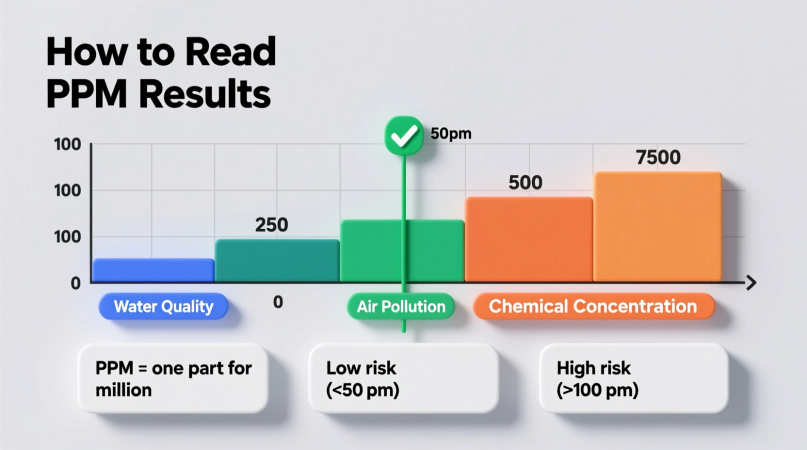
How to Read and Interpret PPM Results Correctly
Understanding how to read and interpret PPM (parts per million) results is crucial for anyone testing water, air, food, or chemicals. PPM is a standard unit for measuring very small concentrations, and interpreting these numbers correctly can help you safeguard health, ensure compliance, and make informed decisions.
In this guide, I’ll explain how to read your PPM results, compare them against safe standards, and what to do if your results are outside the recommended range.
What Do PPM Results Mean?
PPM Values
PPM stands for parts per million, a unit that expresses how many parts of a substance are present in a million parts of a mixture. In water testing, 1 ppm means 1 milligram of a substance per liter of water (1 mg/L). In air or solids, PPM can refer to volume or mass, but the core concept remains the same: it’s about measuring trace amounts.
Where You’ll Encounter PPM Results
- Water testing: TDS, chlorine, nitrates, heavy metals, fluoride
- Air quality: Carbon monoxide, ozone, volatile organics
- Food/lab analysis: Additives, contaminants, nutrients
PPM readings can come from digital meters, colorimetric test kits, or laboratory reports.
Step-by-Step: How to Read PPM Test Results
Step 1: Confirm the Units
Most water and lab tests report results in ppm or mg/L (which are equivalent for dilute solutions). If your results are in another unit—like mg/kg or ppb—use a conversion tool such as the MG/L to PPM Calculator to standardize your data.
Step 2: Identify the Substance Measured
Every PPM value should be linked to a specific substance. For example, is your result for total dissolved solids (TDS), chlorine, nitrate, or lead? The interpretation depends on what you’re actually measuring.
Step 3: Compare Your Results to Standards
Reference safe or recommended limits for the substance you’re testing. Here are some common benchmarks for drinking water:
| Substance | Safe PPM Limit (Drinking Water) | Source |
|---|---|---|
| TDS | < 500 ppm | EPA/WHO |
| Chlorine | 0.2–0.5 ppm (max 5 ppm) | EPA/WHO |
| Nitrate (as N) | < 10 ppm | EPA/WHO |
| Lead | < 0.01 ppm | EPA/WHO |
| Fluoride | < 1.5 ppm | WHO |
For more, see Safe PPM Levels for Drinking Water.
Step 4: Interpret the Numbers
- Below the recommended limit: Safe and acceptable for use or consumption.
- At or near the limit: Exercise caution, monitor regularly, and consider reducing exposure.
- Above the limit: Take corrective action—such as filtration, treatment, or consulting a professional.
For a deeper dive, see How to Measure PPM in Drinking Water.
Step 5: Consider the Context
Track Trends Over Time
A single result tells you the current state, but tracking PPM readings over days or months can help you spot gradual changes or sudden spikes—essential for early intervention.
Account for Source and Conditions
PPM can vary between taps, wells, or different water sources. Environmental factors (like rain or drought) may also affect results.
Know the Limitations
Some tests (like TDS meters) measure total concentration but don’t specify which substances are present. For specific contaminants, use targeted test kits or laboratory analysis.
For more practical advice, see PPM Calculation Mistakes.
Practical Examples: Interpreting Real PPM Results
Example 1: TDS in Drinking Water
You measure TDS at 350 ppm using a digital meter.
- Interpretation: This is below the EPA/WHO limit of 500 ppm, so your water is generally safe, though under 300 ppm is ideal for taste and appliances.
Example 2: Chlorine Residual
A chlorine test strip shows 2 ppm in your tap water.
- Interpretation: This is within the safe range for disinfection.
Example 3: Nitrate in Well Water
A lab test finds nitrate at 15 ppm.
- Interpretation: This exceeds the recommended limit of 10 ppm—especially risky for infants and pregnant women. Treatment or another source is advised.
For more worked examples, see PPM Calculation Examples.
Tips for Accurate Reading and Interpretation
Calibrate and Maintain Equipment
Regular calibration keeps meters and test kits reliable. Follow manufacturer guidelines for best results.
Use Clean Sampling Techniques
Always use clean, contaminant-free containers when collecting samples.
Test Regularly
Periodic testing helps you catch problems early and ensures ongoing safety.
Record and Review Results
Keep a logbook or spreadsheet of your readings—this helps identify trends and provides valuable evidence for troubleshooting.
For more lab advice, see PPM Best Practices for Lab Work.
Frequently Asked Questions
Is 1 mg/L always equal to 1 ppm?
For water and dilute solutions, yes. For other media, check the density or consult PPM Formula Variations.
What if my PPM result is unexpectedly high?
Retest to confirm, check for contamination, and consult a water quality expert if the issue persists.
Can I compare PPM results across different substances?
Always compare your results to the correct standard for each substance. Each has its own safety or regulatory limit.
For instant conversions and expert guides, try the PPM Solution Calculator .
Ready to interpret your results? Use our Safe PPM Levels for Drinking Water guide and the PPM Solution Calculator for quick answers.

Dr. Robert is an industrial chemist specializing in process control, water purification, and quantitative chemical analysis. She has worked with environmental labs and manufacturing facilities to optimize solutions in parts-per-million (PPM) precision and safety compliance.
At PPMCalculator.com, Dr. Robert ensures the accuracy of each calculator and guide through peer review and data validation. Her mission is to make chemistry tools more reliable for engineers, researchers, and students worldwide.
Follow her professional updates on LinkedIn or contact via info@ppmcalculator.com. For More details, Click here
